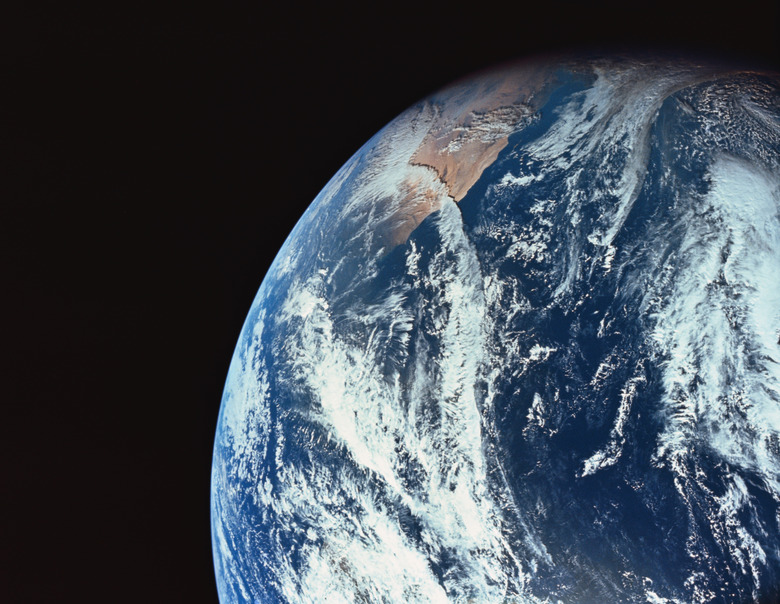Five Levels Of The Biosphere
The biosphere consists of all living organisms on Earth, including human beings and other animals, plants and microorganisms, along with the organic matter they produce and all of the non-living abiotic elements necessary for life. All of these elements interact in some form, from the nutrients carried across deep ocean currents and individual organisms migrating across the globe to the minute interactions that occur between organisms living within a remote cave.
The term "biosphere" was coined by Eduard Suess in 1875 but was further refined in the 1920s by Vladimir Vernadsky to denote its current scientific usage. The biosphere has five levels of organizational structure.
Earth's Biomes
Earth's Biomes
The biosphere is divided into regions called biomes. Biomes are the largest of the five levels of organization in the biosphere. Scientists classify biomes into five main types – aquatic, desert, forest, grassland and tundra. The main reason for classifying the biosphere into biomes is to highlight the importance of physical geography and environmental conditions on communities of living organisms.
A biome may contain numerous different ecosystems and is defined by the geography, climate and the species native to the region. Factors to determine climate include average temperature, amount of rainfall and humidity. When classifying species within a biome, scientists traditionally focus on the types of vegetation native to a particular region and the types of animals that they typically support.
Ecosystem Characteristics
Ecosystem Characteristics
Ecosystems are the second organizational classification when examining the five levels of the biosphere. An ecosystem contains all of the interactions between biotic factors such as animals and plants, and abiotic factors such as oxygen, nitrogen and carbon. Ecosystems are divided based on the interaction and the transfer of energy. Within each ecosystem, energy is consumed and matter is cycled in the form of chemicals and nutrients among different groups of organisms and their environment.
A basic example is that primary producers, such as plants, obtain energy from the sun through photosynthesis. Then the consumers, such as herbivores and omnivores, eat the plants to obtain energy. When the animals die, decomposers, such as fungi, break down their organic matter and release chemicals that enrich the soil, allowing plants to grow.
Communities of Species
Communities of Species
A community is the third level of organization in the biosphere. Multiple populations of species make up a community. Communities share a particular habitat or environment. The communities in a particular location are limited to species that can survive given the region's abiotic factors such as temperature, pH and nutrients found in the air and soil. The communities of species are also limited by biotic factors such as predators and available food sources.
Population Count
Population Count
A population, the fourth level of biosphere organization, includes all members of a single species living in a particular habitat. A population can include thousands of members or only a single individual. The addition or removal of a population can affect an entire ecosystem.
Indicator species are important groups that scientists use to determine the health of an ecosystem, while the presence of keystone species can result in profound effects for ecosystem as a whole.
At the Base: Organisms
At the Base: Organisms
Organisms, the final level of biosphere organization, are defined as living creatures that use DNA to replicate. Organisms are usually classified in one of two ways: by their cellular structure or by the way they obtain energy. Cellular structure divides organisms into prokaryotes, with free-floating DNA inside cells without a nuclei, and eukaryotes, whose DNA is contained in cell's nucleus.
Organisms are considered either autotrophs, such as plants, which obtain energy by feeding themselves, or heterotrophs, such as animals, which must consume other organisms to obtain energy.
Cite This Article
MLA
Kang, Starr. "Five Levels Of The Biosphere" sciencing.com, https://www.sciencing.com/five-levels-biosphere-8232516/. 30 September 2021.
APA
Kang, Starr. (2021, September 30). Five Levels Of The Biosphere. sciencing.com. Retrieved from https://www.sciencing.com/five-levels-biosphere-8232516/
Chicago
Kang, Starr. Five Levels Of The Biosphere last modified March 24, 2022. https://www.sciencing.com/five-levels-biosphere-8232516/
